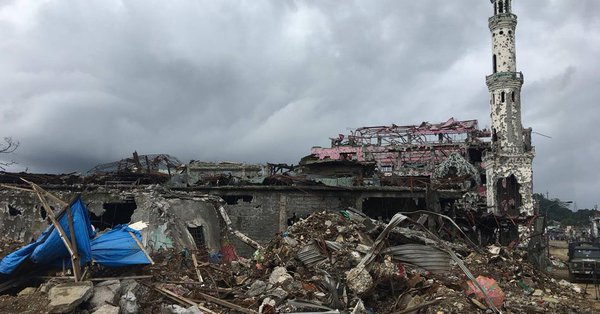
The Philippines is now the site of the greatest terrorism threat in Southeast Asia. That much is clear from the dramatic developments in the southern island of Mindanao during 2017. For some five months, a group of pro-Islamic State (IS) jihadists captured and held parts of the city of Marawi in the province of Lanao del Sur.
That prompted a massive counteroffensive by the Philippines military that included extensive bombing of the city. Apart from Filipino fighters, jihadists from elsewhere in the region and the Middle East also took part in the battle. Casualties exceeded a thousand, and more than 300,000 people were displaced.
This was the most significant jihadist operation in Southeast Asia since the 2002 Bali bombings and it was the first time that a Southeast Asian city had been taken by Islamists. Like the Bali attack, Marawi has captured the attention of jihadists globally, and has inspired emerging extremists.
IS media outlets in the Middle East have begun featuring Marawi in their videos and online publications, urging jihadists from across the globe to join the cause in Mindanao. There are already signs that dozens, perhaps hundreds, of prospective fighters have left for the southern Philippines or are seeking to go there.
The Marawi conflict has exposed the low competence of Philippines security services in combatting armed jihadists in urban settings, as well as the failures of President Rodrigo Duterte’s government in managing the propaganda fallout. There’s a high likelihood that Mindanao will entrench itself as the centre of pro-IS extremism in Southeast Asia, helping jihadists from around the region to gain the skills needed to escalate operations in their own countries.
Fighting broke out between the jihadists and government forces in Marawi on 23 May 2017, after Philippines military units discovered Isnilon Hapilon—the IS emir in Southeast Asia and a commander of the local Abu Sayyaf Group (ASG)—hiding in the city. Up to 500 jihadists from ASG and other Mindanao-based militants from the Maute Group launched operations against army and police facilities, quickly taking strategic sites. The distinctive black flags of IS were soon displayed in many parts of the city.
Government spokesmen boasted that the jihadists would quickly be defeated. But it soon became apparent that they grossly underestimated the difficulty of the task. The Hapilon–Maute forces were well entrenched in a part of the city that featured fortified buildings and tunnels—a product of the frequent clan conflicts (rido) in that part of Mindanao.
The jihadists were well armed and adept at ambushing and sniping at Philippines government soldiers. Alarmed at the rising casualty rate, the Philippines defence forces evacuated the population and began large-scale bombing of the city, causing extensive destruction of buildings and infrastructure. By July 2017, journalists who beheld the devastation began referring to Marawi as ‘the Mosul of Southeast Asia’.
Not until mid-August could the defence forces claim to have gained the upper hand in the battle, confining the jihadists to a few neighbourhoods in one corner of the city. Still, the task of defeating the militants proved difficult, and Philippines soldiers had to conduct the sort of intensive street-by-street urban warfare that they had little expertise in.
On 16 October, the government announced that Isnilon Hapilon and key Maute leaders had been killed in firefights. Eventually, on 23 October, exactly five months after the beginning of the battle, the Philippines military was able to declare that Marawi had been cleared of jihadists.
Despite the eventual defeat of the jihadists, the battle for Marawi was in many ways a strategic and propaganda success for pro-IS forces in the region. The ability of the Hapilon–Maute fighters to seize and control a major city for almost half a year, and to withstand the Philippines Army’s counterattack, won them valuable regional and international credibility in jihadist circles.
The presence of as many as a hundred US advisers to the army, as well as US and Australian intelligence support, added to the propaganda dividend for the jihadists, allowing them to cast the battle as not just a local conflict, but also as part of a broader global Muslim–Christian contest.
Moreover, the jihadists succeeded in drawing the Philippines defence forces into a massive overreaction that has alienated the local Muslim population and added to the already deep levels of resentment towards Manila’s handling of Islamic issues. Most of the damage to buildings and infrastructure in Marawi resulted from the defence forces’ bombardment, not from jihadist actions. This allowed the jihadists to portray the Philippines government, rather than themselves, as the source of suffering and destruction.
But, above all else, Marawi showed that the southern Philippines, with its porous borders, tenuous government control over large land areas, and corrupt and inept security services, is the most favourable site in the region for training jihadists and mounting major operations.
At a time when IS in Syria and Iraq is shrinking rapidly after a succession of military defeats, Mindanao stands as one of the more promising new theatres of activity. This elevated profile was evident when the Philippines received cover-story status in the IS Rumiyah magazine in June 2017, the first time that Southeast Asia had so featured. Similarly, editions 3 and 4 of the Inside the Caliphate videos from the IS Al-Hayat Media Centre were also devoted to Marawi and Mindanao.
Although there has been no serious resumption of IS-related violence in Mindanao since late 2017, the long-demonstrated regenerative capacities of Filipino jihadism suggests that Marawi-style operations are unlikely to be a one-off phenomenon.

No comments:
Post a Comment
Note: Only a member of this blog may post a comment.